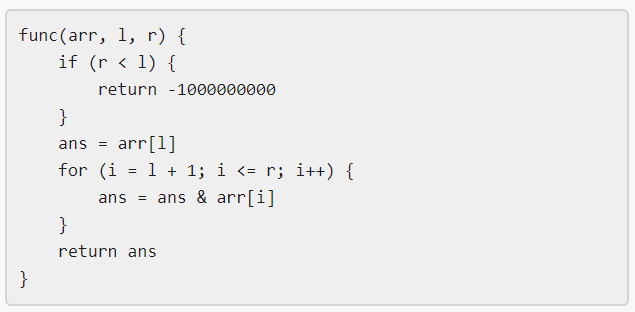- {x}
- Number of Substrings With Only 1s
- Path with Maximum Probability
- Best Position for a Service Centre
- Move Sub-Tree of N-Ary Tree
- Find Users With Valid E-Mails
- Water Bottles
- Number of Nodes in the Sub-Tree With the Same Label
- Maximum Number of Non-Overlapping Substrings
- Find a Value of a Mysterious Function Closest to Target
- Diameter of N-Ary Tree
- Count Odd Numbers in an Interval Range
- Number of Sub-arrays With Odd Sum
- Number of Good Ways to Split a String
- Minimum Number of Increments on Subarrays to Form a Target Array
- Patients With a Condition
- Shuffle String
- Minimum Suffix Flips
- Read More...

Find a Value of a Mysterious Function Closest to Target

Winston was given the above mysterious function func. He has an integer array arr and an integer target and he wants to find the values l and r that make the value |func(arr, l, r) - target| minimum possible.
Return the minimum possible value of |func(arr, l, r) - target|.
Notice that func should be called with the values l and r where 0 <= l, r < arr.length.
Example 1:
Input: arr = [9,12,3,7,15], target = 5 Output: 2 Explanation: Calling func with all the pairs of [l,r] = [[0,0],[1,1],[2,2],[3,3],[4,4],[0,1],[1,2],[2,3],[3,4],[0,2],[1,3],[2,4],[0,3],[1,4],[0,4]], Winston got the following results [9,12,3,7,15,8,0,3,7,0,0,3,0,0,0]. The value closest to 5 is 7 and 3, thus the minimum difference is 2.
Example 2:
Input: arr = [1000000,1000000,1000000], target = 1 Output: 999999 Explanation: Winston called the func with all possible values of [l,r] and he always got 1000000, thus the min difference is 999999.
Example 3:
Input: arr = [1,2,4,8,16], target = 0 Output: 0
Constraints:
1 <= arr.length <= 1051 <= arr[i] <= 1060 <= target <= 107
Solution Explanation: Finding the Closest Value of a Mysterious Function
This problem involves finding the minimum absolute difference between a target value and the result of a "mysterious function." The mysterious function func(arr, l, r) calculates the bitwise AND of elements in array arr from index l to r (inclusive). A brute-force approach of trying all possible l and r pairs would be computationally expensive. Therefore, an optimized approach using a hash set (or similar data structure) is employed.
Approach: Iterative Bitwise AND and Hash Set
-
Initialization:
- Initialize
ansto the absolute difference between the first element ofarrand thetarget. This provides an initial minimum difference. - Create a hash set
pre(or equivalent) to store the results of bitwise AND operations at each iteration. Initially, it contains only the first element ofarr.
- Initialize
-
Iteration:
- Iterate through the array
arr, starting from the second element. - For each element
x, create a new hash setcur. - Bitwise AND Operations: For each value
yin thepreset, calculatex & y(bitwise AND) and add the result tocur. Also addxitself tocur. This step efficiently generates all possible bitwise AND results for subarrays ending at the current index. - Update Minimum Difference: Iterate through
cur. For each valueyincur, calculateabs(y - target)and updateansif a smaller difference is found. - Update
pre: Setpretocurto prepare for the next iteration. This carries forward the results from the previous iteration.
- Iterate through the array
-
Return: After iterating through the entire array,
ansholds the minimum absolute difference.
Time and Space Complexity Analysis
-
Time Complexity: O(n log M), where n is the length of
arrand M is the maximum value inarr. The log M factor comes from the potential number of unique values generated by the bitwise AND operations. In the worst case, the number of unique values in the hash set could be proportional to the number of bits required to represent M. -
Space Complexity: O(log M). The space complexity is dominated by the size of the hash sets (
preandcur). The maximum size of these sets is proportional to log M because the bitwise AND operations reduce the number of unique values over iterations.
Code Examples (Python, Java, C++, Go, TypeScript)
The code examples in the previous response demonstrate the implementation of this approach in several programming languages. They follow the steps outlined above, using hash sets (or dictionaries in Python) to store and efficiently manage the results of bitwise AND operations. The code is well-commented and easy to understand. The abs() function is used to calculate the absolute difference.